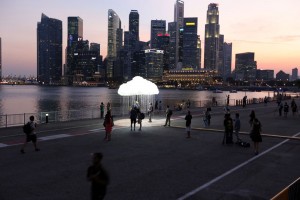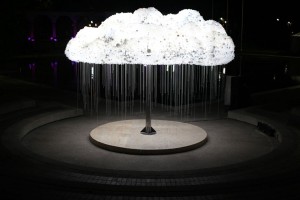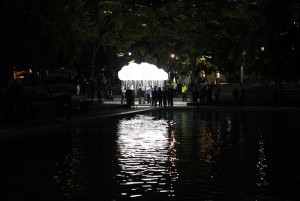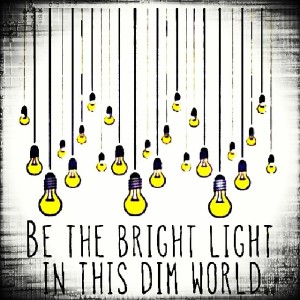Light bulb bewilderment: 4 tips to picking the best one for you

Light bulbs didn’t used to be confusing. They would burn out and you plugged in another incandescent one just as people have been doing since Thomas Edison’s days. But when lighting manufacturers met federal energy-efficiency requirements, bulbs got complicated.
Now, there are many choices – energy-efficient light emitting diodes (LEDs) and compact fluorescent light bulbs (CFLs) – and consumers might not know which is the right one to save money and energy.
Lighting accounts for up to 20 percent of a home’s electricity use, according to Energy Trust of Oregon, which offers this information about the three main categories of energy-efficient bulbs consumers will see on the shelf:
LEDs: Using 85 percent less energy than standard incandescent bulbs, LEDs can last up to 25 years or more. Switching to an LED can save up to $11 a year in energy costs. The latest models are praised for their resemblance to traditional lighting, offering the same bulb shape and familiar, warm light. As technology advances, retailers are quickly dropping prices to as low as $5 or less per bulb, making LEDs a promising new option that can save on energy costs for years to come.
CFLs: Using 75 percent less energy than standard incandescent bulbs, CFLs can last seven to 10 years. Switching to a CFL can save up to $6 a year in energy costs, according to Energy Star. CFL technology has greatly improved in the past couple of years to help address some of the concerns about earlier models. They are also widely available and come in a shape, size or color for nearly any application. CFLs can be a great value, with prices starting under $1 per bulb.
Halogen incandescent bulbs: Incandescent bulbs haven’t gone away altogether, manufacturers just created a more efficient version – the halogen incandescent. These bulbs are 30 percent more efficient than traditional bulbs and offer a similar lifespan of one to five years. They can save up to $4 a year, but with a price of around $3 per bulb, they may not offer the best value over time.
Tips for buying energy-efficient bulbs:
- Pick a bulb type: Before you go to the store, determine if you would like to purchase an LED or CFL and count the number of bulbs you need. Make notes or take pictures of the styles you need to replace and consider the brightness and color you desire.
- Check the lighting facts label. Compare bulbs easily as you shop by reviewing the Lighting Facts label on the packaging. Similar to a Nutrition Facts label for food, this label offers information about brightness, light appearance (warm to cool), how long the bulb should last and estimated annual operating cost. The Federal Trade Commission now requires the Lighting Facts label on all lighting packages.
- Shifting to more efficient technology also means a shift from watts to lumens. Lumens tell you how much light a bulb will provide, watts only tell you how much power it uses. Overall, for a lower lighting level, look for fewer lumens; for brighter light, look for a greater number of lumens. Lumens are listed on the Lighting Facts label.
- Look for Energy Star: Be sure the light you pick is Energy Star labeled. These bulbs save energy and have been tested to ensure quality and performance. Energy Star-rated CFLs and LEDs offer significant advantages over standard incandescent bulbs, both in terms of efficiency and bulb life.
REF — Homes & Gardens of the Northwest staff
-
Commercial Lighting Tampa FL, 813-935-4448 / 813-514-1264 / 813-514-1265 / 813-932-1086 / 813-932-1547 / 813-935-8235
CommercialLightingTampa.com, 8139354448 / 8135141264 / 8135141265 / 8139321086 / 8139321547 / 8139358235
Light It Up: The Connected Home’s Battle Of The Bulbs
Philips has a cheaper Hue, and a new kinetic energy-powered accessory on tap, plus LG and Samsung unveil new smart lights.
Lighting is a key ingredient in the connected home, and the benefits of smartening it up are obvious. Practically everyone has forgotten to turn off a light or fumbled around for the switch. And some find coming back to a dark house creepy. But with smart lights, you can use your smartphone to control or set automations for your lamps and bulbs, and a lot more.
The leader in smart lights is Philips Hue Wi-Fi-enabled bulbs. But the competition just heated up last week, with both LG and Samsung unveiling new smart bulbs.
Not that Philips is sitting idly by. This boss of intelligent bulbs also unveiled two new products: the Hue Lux LED bulb, a cheaper, stripped-down version of its pricey original, and the Philips Hue Tap, an add-on that lets you trigger lights by touch.
A Range Of Hues
Controllable via mobile device, Philips Hue is able to illuminate in multiple colors from a single disco-worthy light and hub. Hue practically started the smart lighting trend and inspired numerous knock-offs.
The issue with Hue is price. A starter kit of three bulbs and a bridge (or hub) will set you back $200. As if to answer the critics, Philips has just announced its new $40 Hue Lux, a smart white lightbulb that swaps features for savings.
Lux works the same as the original, lacking only the color-changing feature. That may seem a bit boring; on the other hand, consider that the original Hue costs $60 per bulb. The Lux starter kit also goes for less, at half the amount of the original starter kit. To help bring the price down, the company stuffed only two bulbs in the kit, along with the bridge, for $100.
Somewhat more interesting is the Hue Tap, a wireless accessory for controlling Hue smartlights that's designed for wall mounting in a convenient location.
The Hue Tap provides an alternative to digging out your phone, waking it up, navigating to the app, etc. just to switch the lights on or off. And since you add it to your Hue Bridge as a wireless controller, it doesn't interfere with the system. When you shut off a lamp manually, Hue may not know what state the light is in. Turn it off with the Tap, and it knows the lights are off.
At first, this $60 accessory seemed a bit silly to me. If you’re going to reach over to touch it, why not save your money and just hit the actual light switch? But the way it draws power changes everything. The juice comes from kinetic energy—when you tap the device, you’re actually charging it. There are no batteries to mess around with, and that absence of cords means that you can put it anywhere—your coffee table, nightstand, or even the side of your fridge.
It’s easy to see the appeal of Hue Tap. If you’ve ever found your light switch’s location inconvenient (or even stupefying—my old apartment inexplicably had a light switch near the ceiling), you’ll be glad to know you don’t have to be bound to the confines of your home’s wiring. The downside, however, is that it relies on your Wi-Fi network to function. So you won’t want to place this anywhere with a weak signal.
Who Will Light The Way?
For connected home companies like SmartThings, Revolv and Zonoff, which powers Staples Connect, as well as services like “If This Then That,” Philips Hue has become the belle of the ball. Numerous parties have flocked to it, making the smart lights compatible with their own systems.
Now LG and Samsung want a piece of the action too.
Last week, LG announced its latest, the LED Smart Lamp. (Google translation here.) These $32 bulbs promise a 10-year life, can be controlled or automated via smartphones, and use Wi-Fi and Bluetooth. The company also pointed out that its lamp can groove to music or blink for smartphone notifications. (Though these have become rather standard features for smart lights. Philips Hue, for example, can do the same.)
Like LG, Samsung’s new Smart Bulb shines a white light and promises a 10-year life, but it does away with Wi-Fi entirely, relying solely on Bluetooth. The communication approaches are interesting, because they both connect directly to phones, which means no costly hubs required, like with Philips Hue.
Samsung hasn’t announced availability or pricing yet, but the latter will likely fall somewhere around $30 to $40. LG’s Smart Lamp is destined for its native South Korea, at least to start. But if it succeeds there, the company will probably consider extending the bulbs to international distribution. Philips, meanwhile, plans to roll out the Hue Tap and Hue Lux in North America and Europe in the latter half of 2014.
None of these options are rock-bottom cheap, especially compared to standard incandescents. Their long life and smart features, though, might tempt some buyers. And with prices starting to come down, we could see an influx of new users setting foot on the smart home path. This is undoubtedly the goal.
Though they may lack Philips Hue’s integrations and partnerships, both LG and Samsung run a variety of businesses across consumer electronics, appliances and smart devices. They could essentially fit lighting like a piece in their broader connected-home puzzles.
If those smart lights act like gateway products, whoever dominates that first entry point may light the entire way to their entire eco-system of smart home products.
Feature image courtesy of Flickr user André Mouraux. All others courtesy of respective companies.
REF: readwrite
-
Commercial Lighting Tampa FL, 813-935-4448 / 813-514-1264 / 813-514-1265 / 813-932-1086 / 813-932-1547 / 813-935-8235
CommercialLightingTampa.com, 8139354448 / 8135141264 / 8135141265 / 8139321086 / 8139321547 / 8139358235
Why Are LED Companies Dropping Like Flies?
Major producers of LED Lighting Products unable to turn a profit
March 18th 2014 – San Jose, CA: It was a bit of a shock to hear the week before last that Toshiba had made a decision to cease production of LED Lighting Products (most specifically lamps), stating that they were unable to make a profit given the decline in consumer price levels on LED Light Bulbs. The Vice President of Toshiba stated in a letter dated March 10th, 2014 that Toshiba was struggling to compete against major brands such as Philips, CREE, and Sylvania.
Today came the official announcement that another producer of high quality LED Light Bulbs; Switch Lighting Co. known for their omni-directional A19 Lamp that has received over a dozen awards including named as TIME Magazine’s “The 50 Best Inventions”, and most recently the 2014 CES Innovation Award, will be closing the doors for good.
Other companies such as Evolucia Inc. (OTCBB & OTCQB: ILED) have struggled to maintain a stock value for their investors falling another 11% to .0056 per share. Evolucia, Inc. according to their website engages in the design, manufacture, marketing, and distribution of light emitting diode (LED) lighting fixtures in North America and internationally and is headquartered in Sarasota, Florida.
Based on the latest announcements from these companies, it leaves one wondering how long the LED Lighting Industry has until a major shakedown occurs. It also leaves questions for consumers to wonder if the LED Product warranty offered by any manufacturer is worth more than the box for which it is packaged.
-
Commercial Lighting Tampa FL, 813-935-4448 / 813-514-1264 / 813-514-1265 / 813-932-1086 / 813-932-1547 / 813-935-8235
CommercialLightingTampa.com, 8139354448 / 8135141264 / 8135141265 / 8139321086 / 8139321547 / 8139358235
The Bright Side of the New Bulbs
A look at what’s replacing the old incandescent and compact fluorescent bulbs.

REF: The New York Times
-
Commercial Lighting Tampa FL, 813-935-4448 / 813-514-1264 / 813-514-1265 / 813-932-1086 / 813-932-1547 / 813-935-8235
CommercialLightingTampa.com, 8139354448 / 8135141264 / 8135141265 / 8139321086 / 8139321547 / 8139358235
Basking in a New Glow

If you haven’t noticed the virtual disappearance of old-school incandescent bulbs from retailers’ shelves, there’s good reason.
With the federally mandated phaseout of traditional incandescent bulbs entering its final stage, manufacturers and retailers have done well to make the transition nearly invisible to consumers. As of last month, companies could no longer produce or import 40-watt and 60-watt bulbs, following similar restrictions on 75-watt and 100-watt bulbs over the last two years.
Some retailers still have enough 40s and 60s to last a few months, but you may struggle finding them amid the thicket of new lights labeled “40-watt equivalent,” “60-watt equivalent” and the like. While those new bulbs will cost more up front, they can save money in the long term because they require less wattage to produce the same amount of light.
That said, prices on newer bulbs are dropping quickly, even as design and performance improve. So if you lack the energy or money to pursue a lighting overhaul in your home now, sit tight. Your patience — or wariness, or laziness — shall be rewarded.
“We’re right at the beginning of this,” said Marc Voykovic, national light bulb merchant for Home Depot. “The technology is changing so rapidly you’ll continue to see improvements in bulbs as manufacturers are able to crack the code.”
Not everyone can wait that long. My home’s compact fluorescent lights, or CFLs, have grown so old and dim that I had little choice recently but to jump headlong into the morass of the current light bulb market.
Thankfully I had help. In addition to calling Mr. Voykovic, I contacted Cecilia Dupire, principal of Cezign, an architectural and design firm, and Russell Leslie, a founder of the Lighting Research Center at Rensselaer Polytechnic Institute in Troy, N.Y. Lucas Borntreger, an electrician in Kansas City, Mo., also guided me through a fixture replacement, but more on that later.
My panelists said the biggest changes in the lighting market have come in the realm of the light-emitting diode, or LED. A few years ago, LEDs were billed as the next big thing, since they are extremely efficient and durable, to the tune of 25,000 hours of expected life.
But the early bulbs came with “you can’t be serious” price tags (as in $40 for a 60-watt bulb) and gave off light that was as soft and warm as a granite quarry in January. Oh, and you couldn’t dim them.
Over the last year, however, manufacturers rolled out dimmable LEDs for less than $10, with light that often rivals the old incandescents.
Are they worth it? Probably.
A 60-watt equivalent LED needs only 12 watts of power to produce the same light as a traditional incandescent. It consumes less than one-third as much energy as the lowest-price bulbs now manufactured: so-called halogen incandescents.
According to the American Council for an Energy-Efficient Economy, based on conservative estimates, consumers who spend $10 on a 60-watt equivalent LED over a 60-watt equivalent halogen incandescent will recoup the difference in about three and a half years, or less if you live in areas like New York, where utility rates are among the nation’s highest. At $5, you recoup your costs in less than 18 months.
(The Lighting Research Center’s website, www.lrc.rpi.edu, has a cost calculator to help consumers select bulb types. Look for the “Lighting Patterns for Homes” section, and choose the “rooms” category.)
Some LEDs have more recently breached that $5 barrier, thanks to incentives from electric utilities provided for bulbs that carry the government’s Energy Star rating. Last week in Vermont and Pennsylvania, among other states, retailers carried 40-watt LED bulbs for roughly that price.
As newer LEDs gain Energy Star certification this year, $5 could become the new normal for 40-watt and 60-watt bulbs.
The big question is whether you can find an LED that gives off your preferred light. I tried eight different 60-watt equivalent LEDs currently on the market from a range of manufacturers, and each of them was rated 2700 Kelvin. On the “Light Appearance” graphic included on the bulbs’ packaging, this was close to the “warm” end of the spectrum.
I expected identical light quality, or close to it, but at least three of the bulbs were noticeably cooler than the others. The warmest, to my eyes, was the Cree, which retails for just under $10. The Philips 11-watt LED bulb, the more expensive of the two Philips 60-watt equivalents, also offered a pleasing amount of warmth. The coolest was the Ikea Ledare E26, which sells for $7.
Mr. Leslie said part of my issue could have been the white background of the light, and that one’s reaction to a certain bulb has much to do with its immediate surroundings. “If you buy an LED in the 2700 to 3000 Kelvin range with an Energy Star label from a manufacturer like Philips, Sylvania, G.E. and Cree, you’ll probably have a satisfactory product,” he said.
To avoid buyer’s remorse, my panelists said, ask questions about light quality at the store, check the retailer’s return policies and save receipts.

Ms. Dupire said LEDs have improved to the point that they represent 80 percent of the lights in her home. That includes traditional bulbs as well as smaller lights that complement lamps and other fixtures.
“What’s wonderful about LEDs is that you can be both playful and functional with them,” she said. “You can do more imaginative stuff, like putting them underneath cabinets or inside closets because they don’t create as much heat.”
Following her counsel, I tried the battery-operated G.E. Wireless LED Light in a closet that inexplicably lacked a socket, and they instantly turned the most irritating space in my house into something functional.
Lamps and old fixtures can also get a playful upgrade with bulbs like the Philips Hue ($60, or $200 for a pack of three) or the Lumen TL800 ($70), which you control with a mobile device. (The Hue works with the iPhone, Androids and Kindles, while the Lumen works with iPhones and certain Android devices. The Hue also includes a BR30 option for recessed lighting fixtures.)
Each bulb has a dedicated app that lets you change colors manually or according to predetermined settings, among other feats. This is especially useful if you have trouble waking up or falling asleep and would like ambient colors to help you in either regard.
I liked both bulbs very much, but I favored the brightness and versatility of the Hue. The setup is slightly more complicated, however, since you need to plug a base station into your wireless router. The Lumen works with a Bluetooth connection.
Outside of LEDs, my panelists said, little has changed in the consumer light bulb market. Manufacturers have tweaked the efficiency of their halogen incandescents to meet the new federal standards, and manufacturers say they expect these bulbs to dominate the market while the LEDs edge their way into the mainstream.
Manufacturers said CFL technology has stagnated, and my panelists echoed that sentiment. But I found one exception worth noting. The Plumen 001 ($30) and the Baby Plumen 001 ($29) feature a cool variation of the traditional “twisty” CFL design. The company also sells single bulbs packaged with a sleek, matching hanging fixture for $65.
The light is warm and pleasant by fluorescent standards, but like many other CFLs, the Plumens are not dimmable.
I considered installing a set, but the idea of cutting holes in my ceiling and wiring new fixtures was a bit too ambitious. At the same time, I’ve been on the lookout for an electrical project a little more challenging than rewiring a lamp, but preferably in a low-stakes setting.
Like my basement.
It boasts square, recessed fixtures that were installed 40 years ago, and which we, in recent years, lit with junky CFLs. Sometime last year two of the fixtures simply stopped working. It was almost an improvement.
I heard about a new LED product, the Pixi FlatLight luminaire, that’s advertised as an ideal replacement for such Nixon-era fixtures. The Pixi is less than an inch thick — including the (nonreplaceable) light itself — and comes in three sizes. I chose the 1-foot square size ($70 each), as it is nearly identical to our existing fixtures.
My only remaining task was to figure out how to install it without electrocuting myself or creating a fire hazard in my house. Pixi offers a good how-to video, but it didn’t account for the wiring configuration in my basement. Rather than call an electrician for a visit, I tried a new online service from Google, called Helpouts, in which contractors and other professionals offer advice through video chats.
The professionals are reviewed by Google, but as with anyone you might contract for home-repair services, would-be customers should check out the professional’s credentials before going forward.
Mr. Borntreger, for instance, is a licensed master electrician with extensive experience. For $15 he offers 30 minutes of advice. After two calls and about an hour of work, I installed four fixtures, and did it with the confidence that I hadn’t ruined the job.
Without Mr. Borntreger I would have known to shut off the light circuit at the breaker, and test the fixture with a voltage meter for good measure. But had I not called on him, I most likely would not have looked deeply enough into the junction box to see an additional set of wires that were important.
REF: The New York Times
-
Commercial Lighting Tampa FL, 813-935-4448 / 813-514-1264 / 813-514-1265 / 813-932-1086 / 813-932-1547 / 813-935-8235
CommercialLightingTampa.com, 8139354448 / 8135141264 / 8135141265 / 8139321086 / 8139321547 / 8139358235
No ordinary rain shower: Art installation made from burnt-out bulbs
-
Commercial Lighting Tampa FL, 813-935-4448 / 813-514-1264 / 813-514-1265 / 813-932-1086 / 813-932-1547 / 813-935-8235
CommercialLightingTampa.com, 8139354448 / 8135141264 / 8135141265 / 8139321086 / 8139321547 / 8139358235
Halogen light bulbs? CFL? LED? What's the difference?
Incandescents are history. Now Americans must choose between halogen, CFL, and LED light bulbs. Each has its perks.
Switch75 light LED bulbs come in clear and frosted. LEDs use 70 percent to 80 percent less power than incandescent light bulbs. According to the Energy Department, widespread use of LED bulbs could save the output of the equivalent of 44 large power plants by 2027.
AP/FILE
So what will light the future? For most homes, it'll come down to three options:
RECOMMENDED: The 20 most fascinating accidental inventions
Halogen: These bulbs closely resemble traditional incandescents. Technically, they are incandescent. But the filament is surrounded by halogen gas, which glows just as brightly while using less electricity.
Halogen bulbs turn on instantly, emanate a warm light, and work with dimmer switches. They're also inexpensive – often just a few dollars each. The savings fade over the long term, however. Halogen bulbs burn out much more quickly than competing nonincandescent lights and consume close to three times as much electricity.
Price: $2 each
Consumes: 43 watts
Lifetime: 1,000 hours
Compact fluorescent lamp: CFLs balance cost and efficiency, but with a few drawbacks. The curlicue bulbs turn on slowly – more like a steady realization than a flash of inspiration. General Electric recently introduced hybrid bulbs that use halogen technology for instant illumination as the CFL coil warms up.
CFL and hybrid bulbs contain mercury, which requires careful disposal, and do not work with dimmer switches.
Price: $3 each
Consumes: 13 watts
Lifetime: 10,000 hours
Light-emitting diode: LEDs may be the light on the horizon. Over the past few years, manufacturers have greatly reduced the cost and improved the hue of these very efficient bulbs. Different models can match the warm tones of incandescents or the cool look of CFLs.
While the price of LEDs can seem burdensome at first glance, manufacturers insist the instant-on lights pay for themselves thanks to their long lifetimes. As production ramps up and costs continue to fall, LED lights could sweep the market, going from roughly 3 percent of light bulb sales today to 66 percent by the end of the decade, according to the research firm IHS in Englewood, Colo.
Price: $12-$30 each
Consumes: 10 watts
Lifetime: 25,000 hours
REF: The Christian Science Monitor
-
Commercial Lighting Tampa FL, 813-935-4448 / 813-514-1264 / 813-514-1265 / 813-932-1086 / 813-932-1547 / 813-935-8235
CommercialLightingTampa.com, 8139354448 / 8135141264 / 8135141265 / 8139321086 / 8139321547 / 8139358235
Dim World…
-
Commercial Lighting Tampa FL, 813-935-4448 / 813-514-1264 / 813-514-1265 / 813-932-1086 / 813-932-1547 / 813-935-8235
CommercialLightingTampa.com, 8139354448 / 8135141264 / 8135141265 / 8139321086 / 8139321547 / 8139358235
Great, Now Even Light Bulbs Are Spying On You
PHILIPS'S NEW LIGHTING SYSTEM CAN TALK (AND BEAM ADS) TO YOU AT THE GROCERY STORE.
Here is Philips's vision for the future of the grocery store. You enter the store. You take out your phone, and open up the Philips app. You're presented with a map of the store, along with your precise location in it. Maybe you type in that you want to cook a specific dish that night, and the Philips app gives you specific directions around the store to get the ingredients you need. As you're doing that, ads from the grocery store will appear on your phone–buy one get one free of this, half off that.
Philips is demonstrating this very setup in a retailer in Dusseldorf, right now.
The most intriguing thing about this is that it all comes from light: the entire setup is built into the overhead lights in the store. Philips, one of the biggest names in lighting (and especially in the new world of low-cost LED lighting), has figured out a way to use light as a communications method.
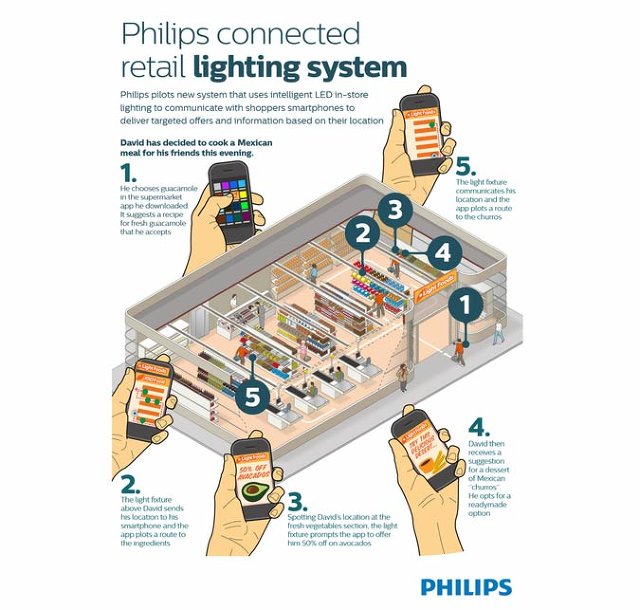
Basically: light has a whole bunch of different wavelengths, only some of which can be seen by human eyes. So these lights beam out just a tiny bit of data in a wavelength that we can't see–but that your smartphone camera can. That little bit of data is then read by your phone in the same way as a QR code–a QR code gives your phone a URL, which your phone then translates to a video or whatever. Philips's system works the same way.
Menno Kleingeld, general manager for Philips's indoor lighting business, told me that the system won't require you to point your phone at the lights; your phone picks up the special light frequency from ambient light. "You see more and more people with smartphones in their hands when shopping, anyway," he says.
There are two primary concerns with an app like this. The first is that it's creepy–an invasion of privacy that gives businesses and corporations an avenue to slurp a consumer's data and hurl advertising their way. That said, "It's totally opt-out," Kleingeld says, meaning that you have to actually download this app to connect to the system at all. Don't want your grocery store to know your location and shopping history? Just don't download the app. (This, of course, assumes that people fully understand what they're getting into when they download apps.)
The other concern: Will people even bother to download an app? What's in it for them? You could be in a hurry, need to finish your shopping list and need the most efficient way through a store," Kleingeld says, "or it could be triggered when you pass a certain item on a shelf" and are alerted to its existence, usefulness in whatever you're cooking, or some deal. "It could also be coupled to loyalty cards," he says.
For Philips, it's a futuristic way to pitch an expensive, futuristic lighting system (Philips hasn't released pricing yet, but it won't be cheap) to retailers who might otherwise opt for an $8 fluorescent bulb from Home Depot. And a way to compete with Apple, which has a similar system called iBeaconthat's already been rolled out in chains like Macy's (iBeacon differs in that it uses Bluetooth rather than this cool light-data setup).
-
Commercial Lighting Tampa FL, 813-935-4448 / 813-514-1264 / 813-514-1265 / 813-932-1086 / 813-932-1547 / 813-935-8235
CommercialLightingTampa.com, 8139354448 / 8135141264 / 8135141265 / 8139321086 / 8139321547 / 8139358235
Philips announces Energy Star certified 75- and 100-watt replacement LEDs
 (Credit: Colin West McDonald/CNET)
(Credit: Colin West McDonald/CNET)
If you've been waiting for brighter and more affordable options in the LED aisle, then you're in luck.
Today, Philips announced Energy Star certification for their second-generation 75- and 100-watt replacement LEDs, along with exclusive discounts on both bulbs at Home Depots nationwide. Combined with the regional utility rebates that come with Energy Star certification, this means that consumers in some parts of the country will be able to purchase the 75-watt replacement for less than $10, with the 100-watt replacement going for just under $15. For the rest of us, the bulbs will retail for $19.97 and $24.97, respectively.
Both bulbs give off an impressive amount of light. The 75-watt replacement glows at 1,220 lumens, which is noticeably brighter than the 1,125 lumens or so that you'll get from a common 75-watt incandescent. As for Philips' 100-watt replacement LED, it gives off 1,680 lumens, an even more noticeable bump in brightness from the 1,500 lumens that a comparable 100-watt incandescent will put out.

Philips' 60-, 75-, and 100-watt replacement LEDs. Bright, brighter, and brightest.
(Credit: Colin West McDonald/CNET)
Aside from the differences in price and brightness, there's not much separating the two bulbs from one another. Each one glows at a warm, soft white color temperature of 2,700K, and like most LEDs these days, both are rated to last 25,000 hours (just under 23 years at three hours a day). Both bulbs use a common A19 base, so you can expect them to fit into most standard household lamps and light fixtures.
The 75-watt replacement uses 15 watts, while the 100-watt replacement uses 19. This gives the 75-watt replacement an efficiency rating of 81.33 lumens/watt, with an even more impressive 88.42 lumens/watt for the 100-watt replacement. Compare that with the traditional 15 lumens/watt that you get from incandescent bulbs, and you can begin to see why Energy Star is on board with these LEDs.
Compare the two of them with Philips' own 60-watt replacement LED, however, and you'll notice a slightly different design, with the higher wattage bulbs separated into three sections for more efficient heat dissipation. I was curious to see if this design would lead to any issues with the omnidirectionality of the bulbs' light output, like the slight issue we saw with Philips' SlimStyle LED. In our light box, however, all we saw was bright, evenly dispersed light.
Looking at the bulbs, you'll also notice that both are noticeably longer than Philips' lower-wattage bulbs. If you want to use them in a fixture that doesn't offer a lot of vertical clearance, you may want to break out the measuring tape first.

The Philips 75-watt replacement (left) glows noticeably brighter than the Cree 75-watt replacement (right),
(Credit: Colin West McDonald/CNET)
I was also curious to see how Philips' LEDs would compare with some of the competition, particularly the Cree 75-watt replacement LED. Like the Philips 75-watt replacement LED, Cree's bulb can be found for $19.97 at Home Depot, but unlike Philips, it hasn't received Energy Star certification yet. Cree submitted that bulb for certification in December, and with a testing process that takes three to four months, it should be hearing back sometime soon. With efficiency and lifespan stats similar to the Cree 60-watt replacement LED, which is Energy Star certified, Cree expects their 75-watt replacement to follow suit. For now though, Philips has the pricing edge in those regions that offer utility rebates.
As for the how the two bulbs perform, both are dimmable, and both claim a color temperature of 2,700K — though Cree's take on 2,700K is a bit more yellow than Philips'. Also, the Philips LED is clearly the brighter of the two bulbs, which makes sense given that it claims 1,220 lumens compared to Cree's 1,100. Cree's bulb uses 13.5 watts while the Philips LED uses 15, so the Cree bulb will cost slightly less to use in the long run. Cree can also claim the longer warranty, with 10 years of coverage compared to 5 from Philips.
REF: CNET
-
Commercial Lighting Tampa FL, 813-935-4448 / 813-514-1264 / 813-514-1265 / 813-932-1086 / 813-932-1547 / 813-935-8235
CommercialLightingTampa.com, 8139354448 / 8135141264 / 8135141265 / 8139321086 / 8139321547 / 8139358235
Call Us Today!
813-514-1266
813-935-4448
8135141266
8139354448





